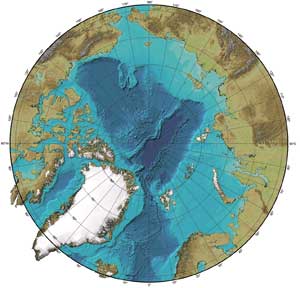|
NEWS NOTES
Science and Society
Cold wars: Russia claims Arctic land
 IBCAO-NOAA-NGDC |
| The underwater Lomonosov Ridge stretches across the floor of the Arctic Ocean between Greenland and Russia, crossing through the geographic North Pole. Russia recently claimed that the ridge is an extension of its continental shelf in a bid to expand its territory to include a large swath of the potentially oil- and gas-rich Arctic seafloor. |
The largest country in the world has ambitions to expand. New evidence from Russian scientists suggests that the North Pole is in an extension of the country’s continental shelf — and that therefore a large chunk of the Arctic, including the North Pole, rightfully belongs to Russia, President Vladimir Putin announced in June. That claim would also include an estimated 10 billion metric tons of hydrocarbons buried under the Arctic seafloor.
Arctic waters have long been in dispute, largely because of the valuable deposits of oil and natural gas that lie below the ice-covered ocean. The region around the North Pole, however, has been considered international territory since 1997, when the U.N. Convention on the Law of the Sea was ratified by 152 nations, including Russia. The law limited the control of the five countries bordering the Arctic — Russia, the United States, Canada, Norway and Denmark, which has sovereignty over Greenland — to economic zones extending to about 320 kilometers from their coasts. None of these zones currently reaches as far as the North Pole. The law allows, however, that a country can extend its economic zone if it can prove that the Arctic seafloor’s underwater ridges are not a separate feature, but a geological extension of the country’s own continental shelf. And that’s just what Russia has set out to do.

 Subscribe
Subscribe


